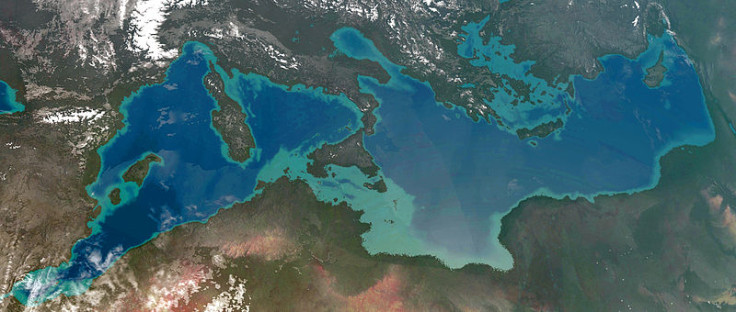Atlantropa: the colossal 1920s plan to dam the Mediterranean and create a supercontinent

Ricarda Vidal, King's College London
Egyptian billionaire Naguib Sawiris recently announced plans to buy a Greek island to give refugees from the Middle East and Africa a country of their own. Though he referred to his proposal as a "crazy idea" on Twitter, Sawiris is serious.
As a radical solution to providing land for the peoples of a war-torn continent, it certainly pales in comparison to an earlier plan from the first half of the 20th century, which was seriously considered by heads of state and, at one point, even the United Nations: the plan for Atlantropa, which would have involved the partial draining of the Mediterranean Sea and the creation of a Eurafrican supercontinent.

A man with big ideas.
wiki
Atlantropa was the brainchild of the German architect Herman Sörgel, who tirelessly promoted his project from 1928 until his death in 1952. His experience of World War I, the economic and political turmoil of the 1920s and the rise of Nazism in Germany convinced Sörgel that a new world war could only be avoided if a radical solution was found to European problems of unemployment, overpopulation and, with Saudi oil still a decade away, an impending energy crisis. With little faith in politics, Sörgel turned to technology.
Dams across the Strait of Gibraltar, the Dardanelles, and eventually between Sicily and Tunisia, each containing gigantic hydroelectric power plants, would form the basis for the new supercontinent. In its final state the Mediterranean would be converted into two basins, with the western part lowered by 100 meters and the eastern part by 200 meters and a total of 660,200 km<sup>2 of new land reclaimed from the sea – an area larger than France.
Later plans for Atlantropa also included two dams across the Congo River and the creation of a Chad and Congo Sea, which Sörgel hoped would have a moderating influence on the African climate making it more pleasant for European settlers. In line with the colonial and racist attitudes of the times, Sörgel envisaged Africa with its resources and its land to be entirely at the disposal of Europe, a continent with plenty of space to accommodate Europe's huddled masses.

Devilm25 / VulcanTrekkie45, CC BY
While Sörgel's proposal may sound absurd to our ears, it was taken seriously by architects, engineers, politicians and journalists at the time. The extensive Atlantropa archive in the Deutsche Museum in Munich abounds with architectural drawings for the new cities, the dams and bridges of the future continent as well as letters of support and hundreds of articles about the project, which appeared in the German and international popular press as well as in specialised engineering and geographical magazines.
What made Atlantropa so attractive was its vision of world peace achieved not through politics and diplomacy, but with a simple technological solution. Atlantropa would be held together by a vast energy net, which would extend from the gigantic hydroelectric plant in the Gibraltar dam and provide the entirety of Europe and Africa with electricity. The power plant would be overseen by an independent body who would have the power to switch off the energy supply to any individual country that posed a threat to peace. Moreover Sörgel calculated that the construction of the supercontinent would require each country to invest so much money and people power that none would have sufficient resources to finance a war.
Putting his faith in the peoples of Europe and their desire for peace, Sörgel dedicated a large part of his work to the promotion and dissemination of the project through the popular press, radio programmes, films, talks, exhibitions and even poetry and an Atlantropa symphony. He hoped popular support would help him get the backing of politicians, which he needed in order to start construction.
Unsurprisingly, in the eyes of his contemporaries the required collaboration between nation states always appeared even more utopian than the vast technological dimensions of Atlantropa. As the New York-based UN World observed in 1948:
Harnessing Gibraltar for mankind's good does sound like a dream, but in this 20th century no dream – not even that of cooperation among nations – is quite impossible.
By 2012, when the European Union was awarded the Nobel Peace Prize in acknowledgement of its contribution to lasting peace in Europe, the hope expressed by the UN World appeared to finally have come true. However, in 2015, cooperation among nations sadly looks like a distant dream once again. Where once Herman Sörgel had used the image of a Europe bursting at the seams that is saved by a peaceful merger with the African continent, we are now confronted with the mirror image as people from across Africa and the Middle East stream towards Europe.
Now would be the time to prove that the Peace Prize was indeed deserved. Now would be the time to show solidarity and unity. Instead, the EU appears on the brink of being torn apart over its inability to find a communal solution to accommodate a group of refugees, whose number ultimately comes to no more than a meagre 0.11% of the overall population of the Union. Sadly European unity, and with it a solution for the refugee crisis, once again appears more utopian than Sörgel's plans for draining the sea.
Ricarda Vidal, Lecturer in Visual Culture and Cultural History, King's College London
This article was originally published on The Conversation. Read the original article.
© Copyright IBTimes 2024. All rights reserved.





